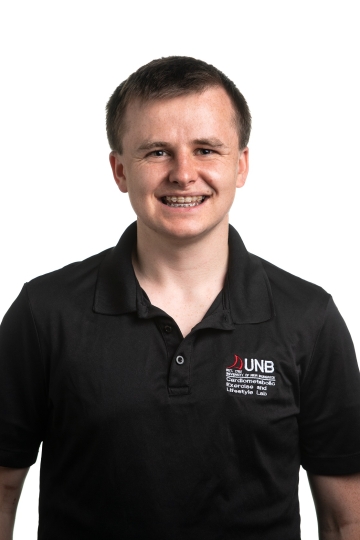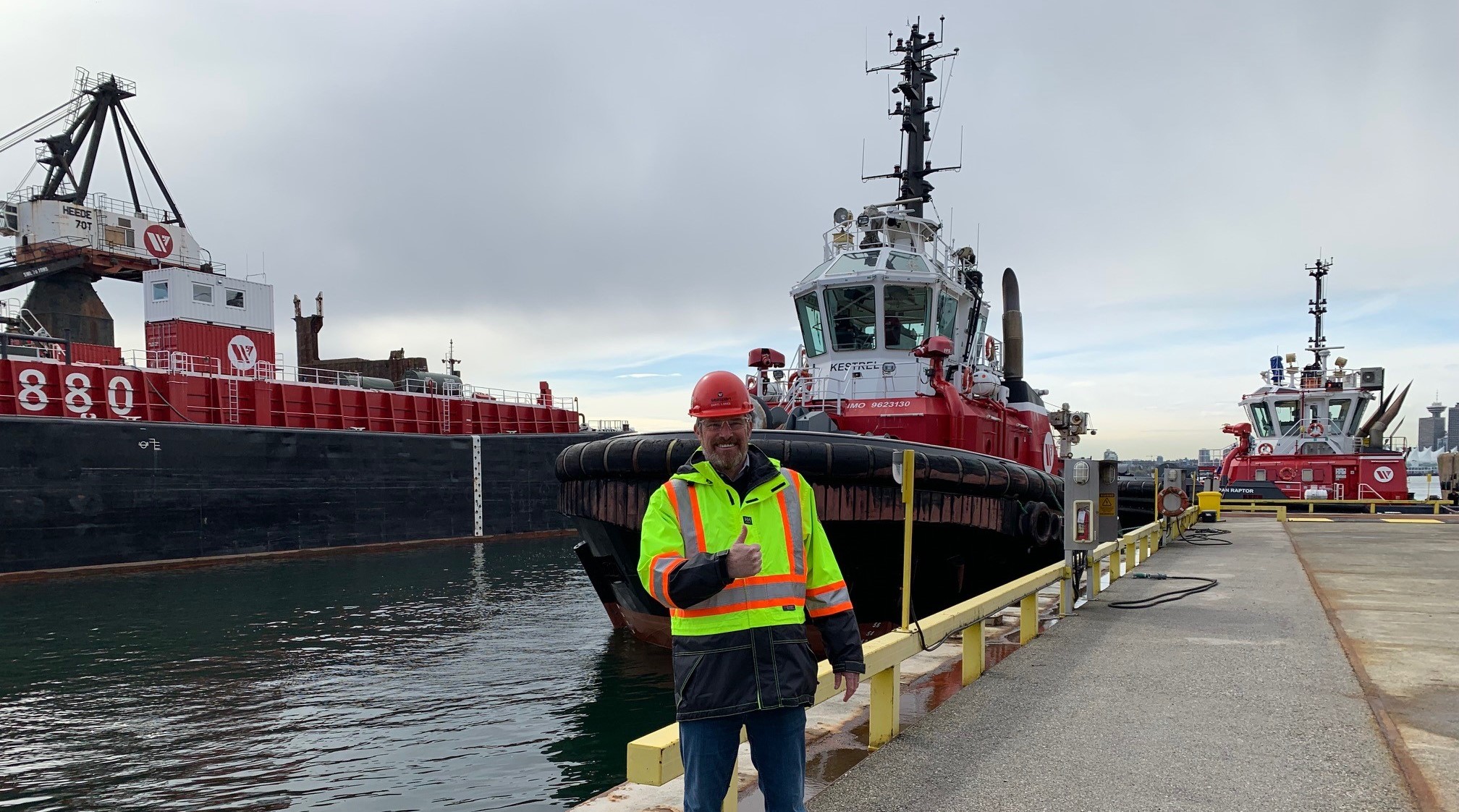
Daryl Lawes in front of one of Seaspan’s many tugboats supporting marine transportation.
Daryl Lawes
Environment Manager
Seaspan Shipyards
Learn About My Career
I am responsible for all aspects of environmental protection, performance, and regulatory compliance for Seaspan Shipyards.
I was born/grew up in: Sidney, British Columbia
I now live in: North Vancouver, British Columbia
I completed my training/education at: Camosun College, Victoria BC – Environmental Technology Diploma
Royal Roads University, Victoria BC – Bachelor of Science
My work involves a wide range of activities that changes every day, which is great. One day I am out on a massive oil barge in the ocean running an oil spill response exercise. The next I might be meeting on a cruise ship to review their wastewater treatment systems. Or I could be participating in a working group to find ways to protect endangered Killer Whales around Vancouver Island. Some days I have a lot of meetings and have to write reports. I visit our shipyards, ferry terminals and especially out on the boats and barges whenever I can.
I use my science background, particularly in biology and chemistry, every day. My background helps me when I am reviewing technical reports such as site assessments, marine habitat surveys, water sampling, noise studies and air quality analysis.
I do a lot of problem solving in my work. For example, I often have to figure out how to carry out such things as ship repair and oil barge operations in the most safe, responsible, and efficient way, while remaining profitable. It is important for industries operating on our coasts to consider environmental and community impact of operations in their decisions. For example, when I make decisions, I try to consider all potential results. I consider where things can go wrong, or what can be improved. Then I work with our highly skilled operational team to plan for them.
A background in STEM helps to understand how industry may affect the communities and our ecologically sensitive B.C. coasts. For example, we now understand how sound produced from ships can affect sonar communication of endangered killer whales. We also understand how certain chemicals in paints may affect the ability of salmonids (salmon-like fish) to reproduce. I use this, and other knowledge, to limit the effects of our operations.
Being able to work as a team is critical in this field. When we are looking for solutions to problems, often the best ideas come from unexpected sources. This means it is important to create a diverse team environment where all feel comfortable to contribute and speak up.
I always knew that I wanted to do something meaningful. I went to university where I started taking general science courses. I discovered that I was very interested in the Environmental fields and completed a BSc in environmental science and management. During my degree program, I took a coop job with the federal government. The pay wasn’t great, but gave me a diverse experience in the environmental field. I got to work on a variety of projects. This included sampling drainage from silver mines in the middle of the Yukon, and species surveys at various National Parks. I even worked on developing a waste management plan at a maximum-security jail! Those experiences inspired me to work in the environmental field.
Our ability to have a negative effect on the environment and communities is becoming more and more apparent these days. It can be discouraging at times, but I am happy with I chose this career path where I can have a real positive influence.
My job is most rewarding when others get involved and excited about protecting the environment. This could be when our engineers are leading the way in battling climate change by building North America’s first high-powered electric tugboats. It might be when a pipefitter comes up with an innovative plan to use bubbles to keep salmon from being trapped in our dry docks. I love that my work is continually advancing environmental protection in real-time.
I also like talking with people in our communities. I especially enjoy working closely with our First Nations across the lower mainland and coasts. Their respect for the land and waters and communities, as well as the resiliency of their people and the kindness they offer to all is inspiring.
The best part of my job working in the Environment field of a private company is that I am actively working to protect our coasts and our communities. At the same time, I am helping the company achieve long-term success. This success includes supporting the economy, jobs, national defence, and transportation of essential goods to coastal communities. Seaspan Shipyards employs over 2,800 of my family, friends, neighbours and fellow B.C. West Coasters.
My relaxing time is spent with my family, in nature, or out on the sports field playing baseball or soccer. Oh, and travelling and seeing the world is a must for me!
Research different careers and opportunities in the field. Talk to people in the specific fields that are of interest to you.
Professional Certifications and designations help, but so does hands on technical and operational experience. It all depends on type of work you want to do.
Find something that you look forward to doing when you get out of bed in the morning!
What I do at work
My work involves a wide range of activities that changes every day, which is great. One day I am out on a massive oil barge in the ocean running an oil spill response exercise. The next I might be meeting on a cruise ship to review their wastewater treatment systems. Or I could be participating in a working group to find ways to protect endangered Killer Whales around Vancouver Island. Some days I have a lot of meetings and have to write reports. I visit our shipyards, ferry terminals and especially out on the boats and barges whenever I can.
I use my science background, particularly in biology and chemistry, every day. My background helps me when I am reviewing technical reports such as site assessments, marine habitat surveys, water sampling, noise studies and air quality analysis.
I do a lot of problem solving in my work. For example, I often have to figure out how to carry out such things as ship repair and oil barge operations in the most safe, responsible, and efficient way, while remaining profitable. It is important for industries operating on our coasts to consider environmental and community impact of operations in their decisions. For example, when I make decisions, I try to consider all potential results. I consider where things can go wrong, or what can be improved. Then I work with our highly skilled operational team to plan for them.
A background in STEM helps to understand how industry may affect the communities and our ecologically sensitive B.C. coasts. For example, we now understand how sound produced from ships can affect sonar communication of endangered killer whales. We also understand how certain chemicals in paints may affect the ability of salmonids (salmon-like fish) to reproduce. I use this, and other knowledge, to limit the effects of our operations.
Being able to work as a team is critical in this field. When we are looking for solutions to problems, often the best ideas come from unexpected sources. This means it is important to create a diverse team environment where all feel comfortable to contribute and speak up.
My career path is
I always knew that I wanted to do something meaningful. I went to university where I started taking general science courses. I discovered that I was very interested in the Environmental fields and completed a BSc in environmental science and management. During my degree program, I took a coop job with the federal government. The pay wasn’t great, but gave me a diverse experience in the environmental field. I got to work on a variety of projects. This included sampling drainage from silver mines in the middle of the Yukon, and species surveys at various National Parks. I even worked on developing a waste management plan at a maximum-security jail! Those experiences inspired me to work in the environmental field.
Our ability to have a negative effect on the environment and communities is becoming more and more apparent these days. It can be discouraging at times, but I am happy with I chose this career path where I can have a real positive influence.
I am motivated by
My job is most rewarding when others get involved and excited about protecting the environment. This could be when our engineers are leading the way in battling climate change by building North America’s first high-powered electric tugboats. It might be when a pipefitter comes up with an innovative plan to use bubbles to keep salmon from being trapped in our dry docks. I love that my work is continually advancing environmental protection in real-time.
I also like talking with people in our communities. I especially enjoy working closely with our First Nations across the lower mainland and coasts. Their respect for the land and waters and communities, as well as the resiliency of their people and the kindness they offer to all is inspiring.
How I affect peoples’ lives
The best part of my job working in the Environment field of a private company is that I am actively working to protect our coasts and our communities. At the same time, I am helping the company achieve long-term success. This success includes supporting the economy, jobs, national defence, and transportation of essential goods to coastal communities. Seaspan Shipyards employs over 2,800 of my family, friends, neighbours and fellow B.C. West Coasters.
Outside of work I
My relaxing time is spent with my family, in nature, or out on the sports field playing baseball or soccer. Oh, and travelling and seeing the world is a must for me!
My advice to others
Research different careers and opportunities in the field. Talk to people in the specific fields that are of interest to you.
Professional Certifications and designations help, but so does hands on technical and operational experience. It all depends on type of work you want to do.
Find something that you look forward to doing when you get out of bed in the morning!
When I was a student I enjoyed:
- Geography
- Science
- Math
When I was a student, I would describe myself as someone who:
- Played on a sports team
- Engaged in volunteer activities
- Wasn't sure what I wanted to do
- Felt at home in the outside, natural environment
Partners
Seaspan Shipyards
Let’s Talk Science appreciates the support of Seaspan Shipyards in connecting us with this individual.
Seaspan Shipyards is a leader in Canada’s shipbuilding and ship repair industry. With modern facilities and a dedicated workforce of 2,700 in North Vancouver and Victoria, Seaspan Shipyards has proven itself to be a trusted partner on a range of complex projects for both government and the private sector. Seaspan Shipyards is proud to be Canada’s chosen non-combat shipbuilder under the National Shipbuilding Strategy (NSS). In this capacity, the company is building state-of-the-art ships in Canada for the Canadian Coast Guard and Royal Canadian Navy. Through its NSS-related work, Seaspan Shipyards is creating jobs, generating economic benefits and rebuilding Canada’s shipbuilding and marine industries.
Related Topics
Explore More Career Profiles
-
Brianna Lummerding
Career Profiles
Agronomic Innovation Manager
I look after all things related to soil management for a group of retailers. -
Li Tan (he/him)
Career Profiles
Molecular Lead
I coordinate the day-to-day operations in the DNA Extraction Lab. -
Tyler Morhart (video)
Career Profiles
Scientist, Beamline Responsible - SyLMAND
I am responsible for the SyLMAND beamline at the Canadian Light Source synchrotron facility. -
Li Tan (Video)
Career Profiles
Molecular Lead
I coordinate the day-to-day operations in the DNA Extraction Lab. -
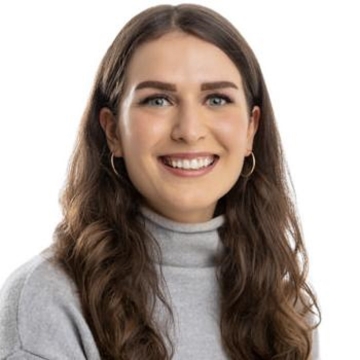
Rashell Featherstone (she/her)
Career Profiles
Senior Program Associate
I coordinate projects for the development of new products at STEMCELL. -
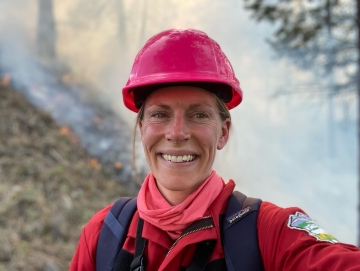
Kira Hoffman (she/her)
Career Profiles
Postdoctoral Researcher/Fire Ecologist
I am a researcher at both a university and a not-for profit organization where I am gaining experience to become a senior researcher. -
Zoë Ehlert (Video)
Career Profiles
Manager, Marker Assisted Breeding
I lead a team that develops canola crops by breeding plants with traits we are looking for. -
Zoë Ehlert
Career Profiles
Manager, Marker Assisted Breeding
I lead a team that develops canola crops by breeding plants with traits we are looking for. -
Jennifer Baltzer (she/her)
Career Profiles
Professor and Canada Research Chair in Forests and Global Change
I work at a university, teaching students and conducting research on the impact of climate change on forests in Canada and around the world. -
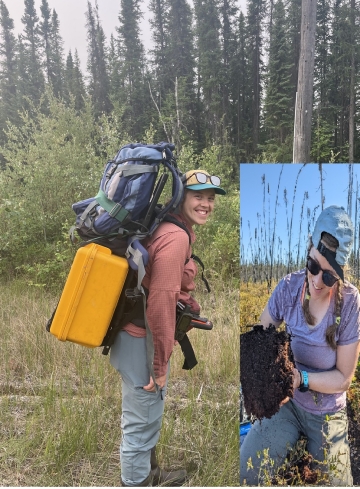
Caitlyn Lyons (she/her)
Career Profiles
Ph.D. Candidate
I am working towards my PhD and studying the forests in the Northwest Territories. -
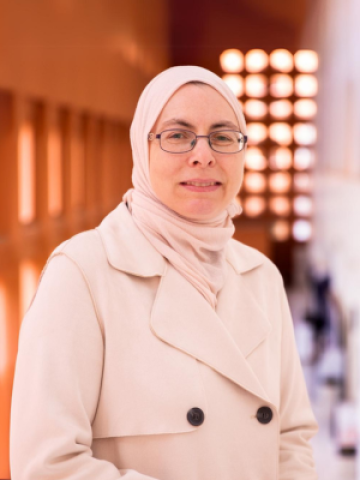
Joann Whalen
Career Profiles
Professor at the Faculty of Agricultural and Environmental Sciences,
I teach advanced courses on how to manage soils to produce healthy, nutritious food and maintain healthy ecosystem functions.
